This page is an automated translation of /nl/sanblas.html and is awaiting a manual review.

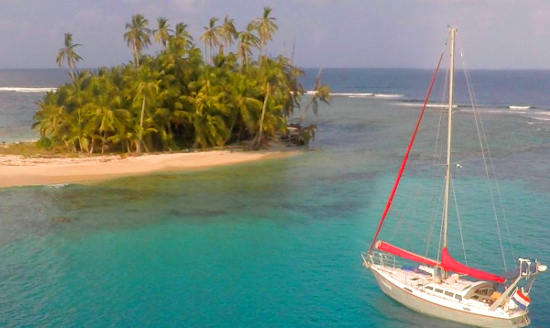
Together on an uninhabited island.
On an uninhabited island
Nobody walks in front of you
Yes, you feel happy because
Good life is the slogan
Drinks with your buttocks bare
Milk from a coconut
On an uninhabited island
Are every day nice
On an uninhabited island
I would like to be there !!
Rustling coconut palms, quiet rustle of the sea. I wake up slowly and remain half dozing, I would like to catch it here and now and flee to it at less fortunate times. This is heaven, this must stay! Frans and I are on the beach of a beautiful uninhabited island. The sea is so blue and clear that it looks like a swimming pool, but one with beautiful fish and special corals! Not that you can see that now, now it is dark. But earlier today we spent the afternoon snorkeling and enjoyed a truly beautiful reef that was just as beautiful or more beautiful than we saw on Bonaire.
After snorkeling, where we often swim hand in hand and squeeze each other's hands and point angrily when there is something special to see somewhere, Frans asks: shall we soon go back to cobble (barbecue) on the beach? Ha, yes! Fun! Collect all the stuff and we jump in the dinghy and carefully sail to the beach. We are at Buborgana, a beautiful little idyllic uninhabited island. If you follow the beach, you can be around in fifteen minutes and all the while you see beautiful clear water, very fine and white sand and in the middle it is dense with beautiful large and small coconut palms.
The surroundings are also beautiful. Wherever you look, you only see the wide sea and here and there other islands with palm trees. Our island is not indicated as an anchorage in the guide and that means that we have the island to ourselves. In the days we are here, we don't see anyone else. After we have finished cobbing, we stay on the beach, under the palm trees and the twinkling stars. The temperature is lovely even in the evening, about 29 degrees, cool enough to lie against each other but still comfortable. No stinging or itching insects on this island!
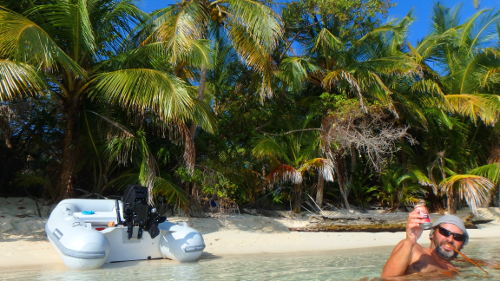
I think back to a few days ago. We were then on our way to a new anchorage 7 miles away. After less than a mile of sailing we saw a beautiful island; Quinquindup. To the south of it was a very small light blue spot. That means sand and that means suitable for an anchor and according to the map the depth had to be good. It looked so beautiful that we spontaneously abandoned our first plan and went to discover this spot to see if it was suitable for anchoring. It was exciting because it was quite close to the reef all around and the sandbar was small. Actually we didn't dare but we had seen the gribfiles and the weather and the sea would remain calm so we chose to stay. We also had the whole day to see if it would go well.
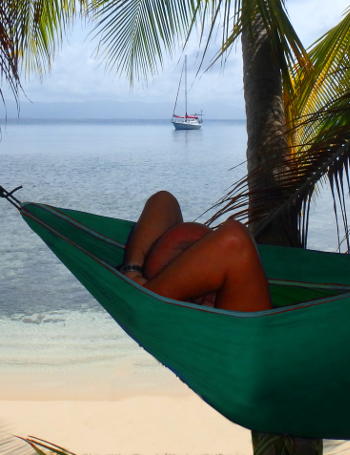
It was heavenly! Hanging up a hammock (thank you, Kim!), Rocking under the coconut trees. For a few days we thoroughly enjoyed the peace, the surroundings, each other. A sundowner in the water every afternoon. That was the most special thing on this island; the surrounding reef provides calm water at the beach. Shallow, warmed by the sun and probably about 35 degrees. So stretch out in the water, in the sun and with a view of the pearly white sand, with a drink. No sauna or bar that can compete with that!
Rushyyyy waving palm leaves wushy waves from the sea, if only you could catch the sounds. If only you could catch the luck. Save a little bit for later. Kuna Yala, how beautiful you are!
Besides enjoying the beautiful uninhabited islands, we also enjoy the completely different culture here, we look out our eyes, spend an evening in a Kuna village and eat at a Kuna family at home. And we also meet some very nice sailors ... Just under two weeks of Kuna Yala leaves an indelible impression on us!
What is that then, Kuna Yala?
Kuna Yala is the original name for the reef-protected beautiful small islands (more than 300 pieces) and a part of the mainland with untouched pure jungle on the coast of Panama in the Caribbean Sea. Although it officially falls under the Panamanian flag, the Kunas have exclusive right of government here. The Spanish conquerors called Kuna Yala San Blas and it is better known by that name but the Kuna themselves prefer to call it Kuna Yala.
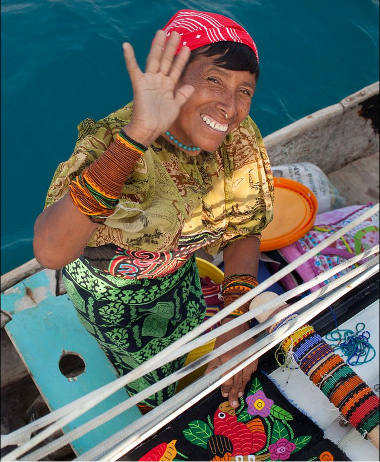
Kuna Indians are one of the smallest people in the world and they are wiry, muscular, dark tanned and have shiny smooth black hair. The Kunas live in huts made of natural materials on their islands in tribes that have a strong family bond, a man who marries a woman moves in with the woman's family. A tribe usually has three chiefs; the Chiefs. Everyone in the community has input, but it is the Chiefs who make the final decisions and have the most influence. Every evening there is a meeting of the community in the "village hut". In that hut there are hammocks in the middle for the chiefs and the rest of the people sit around them.
Kunas move in ulu's, hollowed-out tree trunk canoes, which are powered by a paddle, a sail or - nowadays - an outboard motor. The Kunas, despite their tolerance towards strangers, do not want to mix and that means that if a Kuna wants to marry an "outsider", he must leave Kuna Yala. The disadvantage of this measure is of course that the gene pool remains on the limited side and this causes genetic defects such as albinism to occur, but Kuna's are healthy and grow old. Kuna's are very friendly and tolerant and have a history of remarkably low violence, although after years of exploitation and abuse they eventually chased away the Spanish rulers.
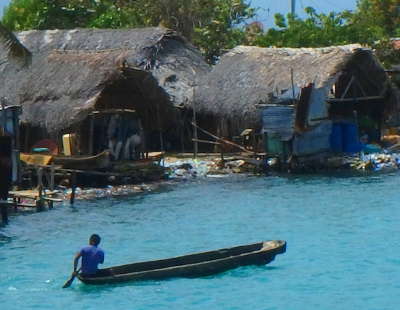
The Kuna Indians are open and hospitable. They wave friendly to sailing boats and when they come to lie alongside in their ulu's they shake hands, tell them their names and also want to know our names, which they always repeat thoughtfully. They also almost always ask about our age; in their culture it is apparently not taboo to inquire about the age of a lady. It is also striking that it seems to be normal in their culture to say that they want a drink when we have bought something from them. They like to sell coconuts and freshly caught fish, the women come to sell molas. Sometimes the Kunas come along to ask if they can charge their cell phones, because sometimes they have cell phones but often no sockets and are therefore dependent on the flow of the sailing boats that pass by. That charging is rewarded with a fish or coconut. Strange conversations arise, for many Kuna's the world consists mainly of their own world and they are very surprised to hear that there are no iguanas in the Netherlands. The communication is done with a lot of gestures because our Spanish is not very advanced and the Kuna's only speak Spanish as a second language.
Sailors
The audience, the sailing tourists, is a different mix than in the rest of the Caribbean: fewer charter boats, more long-term sailors who are either staying in Kuna Yala for months or planning to go to the Pacific. Here, more than elsewhere, the feeling of being dependent on each other prevails because here, apart from fish and coconuts, there is not much else to be found. Spare parts, service technicians, or even help if you unexpectedly sail your boat on a reef, you can forget it. There is therefore a special VHF channel here where the sailors keep in touch with each other, exchange in the morning who hangs out where and make agreements to barbecue together on one or another island. Not the French, of course, they have their own channel and thus stay in their isolation.
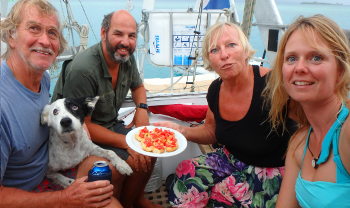
On our route is Green Island, a somewhat larger island that has a freshwater source. When we get there, we unsuspectingly anchor next to another boat ... where people live who appear to know us! It turns out to be a German couple that we met at a party long ago with Wolfgang and Barbara, the previous owners of our boat. The world turns out to be smaller than we thought. Bernd and Sophie have been sailing around San Blas part time for 20 years, part of the year they are sailing in San Blas and part of the year they are "home". Such a chance meeting must of course be celebrated and we have a wonderful evening on their boat.
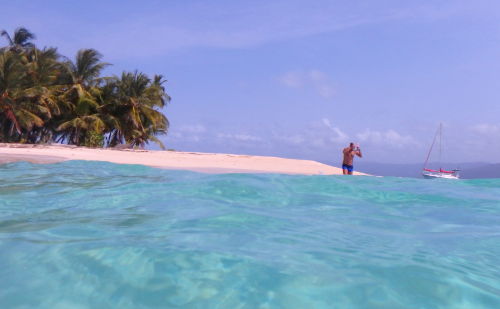
During the time that we are sailing around Kuna Yala we are not cleared, because Porvenir, the place where we can clear, is technically at the end of our route through San Blas. Nobody cares, but in the end we have to clear customs somewhere in Panama, all the more because we also want to go through the Panama Canal. In travel reports of others we read that customs clearance for Panama means nothing, but apparently that has changed quite abruptly: Panama has now discovered that sailing tourism is a cash cow and they now approach it differently. Clearance costs $ 120 per person, you also need a $ 225 "sailing license", and there are city taxes of $ 20 per person plus $ 20 for the boat. Oh yes, they would like to make copies of our papers, and afterwards it turns out that we have to pay 1 dollar per copy in copying costs ourselves. To justify all these costs, of course, the suggestion of work must be done so we are asked to fill out nonsensical questionnaires ("who is the manufacturer of your boat's engine?") That no one is ever going to do anything with, but get in return, all kinds of official-looking papers that are richly stamped (but which we will probably never do anything with). It's all silly, because it is better to let tourists spend money on souvenirs and in restaurants than to have them pay a kind of "tourist fine". As beautiful as Panama and the subcultures are, 500 dollars is quite (too) much money for many cruisers, especially if you are passing through. The local population will probably not get to see this income.
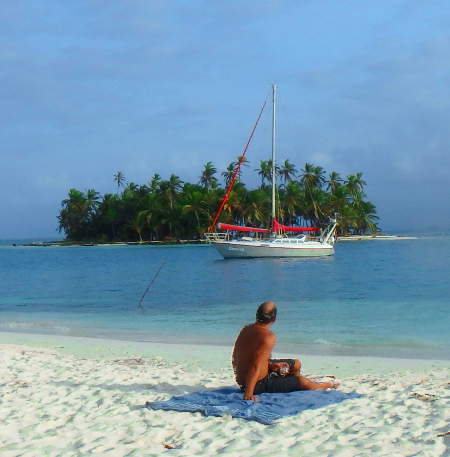
We take customs clearance less and less seriously. We started the journey on fantasy papers, because the Netherlands does not have an official boat passport as other countries know. To cut short the endless discussion with authorities who do not understand anything about it, a Dutch cruiser once designed official-looking papers themselves, placed them on the internet, and because more and more people use fantasy papers, they start to use those papers as official abroad. recognize. If they want additional information (and they always want it), it is increasingly a sport for us to have them fill in the wrong things. Insurance number? We have them transfer the registration number of the insurance with the Chamber of Commerce. Callsign from the boat? Just do this from the "amateur radio license" form. Engine brand? A Vetus. Uh, what, you mean a Volvo? Oh yes, of course, also good. Brand GPS? Um, we have ten devices with a GPS on board, do this one: Nokia. They always want to know who the captain is, so if they more or less assume that it is French, it is automatically Ilona who claims the role of captain. Once you have been on the road for a while, clearing customs in every country becomes just as nonsensical as when you drive around in the Netherlands you have to clear again in every province and answer questions such as "what is the make of your car radio" and then you can best to give it a humorous note.
When we go back to our boat to get more money for clearing our anchor neighbors come to us with their dinghy. It turns out to be a Norwegian couple that we encountered before in Sint Maarten, more than 1000 miles ago. It is always nice to meet acquaintances again, so the Norwegians come to have a chat in their dinghy and tell that they have been invited that evening with their friends to the Kuna village for a meal and tour. They think it would be nice if we can be there too and after they have checked with the Kuna's, it turns out to be no problem if we come along too!
Eating with a Kuna family

It is quite a boat trip in the dinghy to the island where we are invited, from Porvenir it is the second island to the south. When we arrive the table is already set and we are warmly welcomed by a few small children and a few adult kunas. The chairs look a bit strange and under the cushion it appears that the seating furniture actually consists of inverted buckets. We get rice with fish and lentils, nothing special to write home about but of course it is wonderful to dine on raked sand, between the huts made of vegetable material, sitting on upturned buckets! They eat here partly with a fork and partly with their hands, they don't have a knife. Children are playing everywhere, some are curious to see us whites and the Norwegians have brought a football for the children and are stealing the show. Stupid of us, because we have brought along a large box with a few hundred sets of colored pencils especially for these occasions, but it is still deep in our boat; not thought of it at all! Ilona decides to go back quickly before darkness falls to pick up some sets of colored pencils.
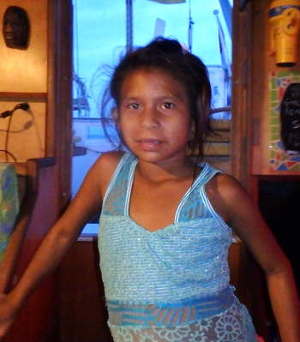
The host immediately asks if one of his daughters can come along because she loves boats so much! We are allowed to look into the village so how could we refuse if someone also wants to see something of us? In the Netherlands you would not easily give your daughter to a foreign stranger, but the people here are full of confidence and so suddenly a young Indian girl is given to Ilona just like that. Carolyn (that's the girl's name) loves it and laughs widely while she races across the water with Ilona. When the dinghy returns, Ilona starts handing out but the bag is quickly taken away by one of the women without a word or thanks and disappears into a hut. But a little later, one by one, the children come out enthusiastically and some spontaneously fly around Ilona's neck in gratitude. It will be the custom here that gifts are only handed out by their own mother or so, but with the gratitude it went well.
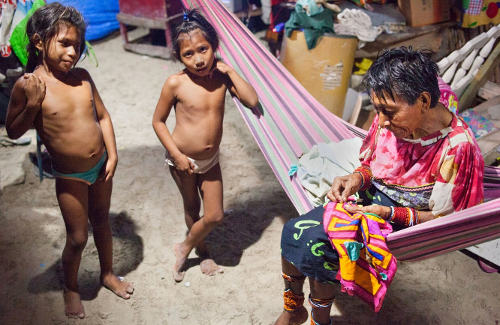
After the meal we get a tour of the village. The streets are made of sand that is regularly swept, everyone walks barefoot and we Europeans also move barefoot without having thought about it. Because you don't wear footwear on sailing boats in the tropics, neither when you go ashore on a sandy beach, so we also arrived barefoot at the Kuna's. We walk through a real village with different streets where there are all huts where the door is open and you can look inside. There are hammocks everywhere where the kunas sleep. At every hut you see a different scene, at one someone is cleaning fish, at the other two small children are washed outside in a grout tub, and at many huts the women are busy making molas. There is a positive, relaxed, pleasant atmosphere.
We also pass the village hall where the meeting is taking place at the time and indeed we see three hammocks with the chiefs and the rest of the people sitting around them. It is all so different from ours that it feels like entering a sanctuary. Kunas don't like pictures, some tribes think that steals their soul, others don't like it and some have no problem with it. We do not dare to take so many photos, even if that would not be a big taboo on this island, although we are absolutely not allowed to take photos of the meeting with the chiefs. In the end we are also allowed to look in the family cabin of our host. Mother-in-law is sleeping in a hammock in a corner. Some kids are just going to bed (um, to hammock). There are no rooms, the hammocks are scattered throughout the room, an old stove is on the side. Everything and everyone in one room. Apparently the need for privacy is also very culture-bound!
Progress?

Because we have been without internet for a while and because we heard that there is a village -Nargana- where they sell prepaid SIM cards for the internet, we decide to visit that village. It is the first village where the kunas have decided to opt for progress. The chiefs have almost nothing more to say. A little progress is of course not possible without electricity and on the island there is a diesel generator for the assembled electricity network, the roar of the diesel engine can be heard all over the island day and night. There is a bank building with a guard in front of the door where the Kuna's can get money (as far as we know also the only one in Kuna Yala) and there is of course a supermarket (you) to be able to spend the money again, otherwise the money is of no use to you. The TV screens that can launch their advertising messages into the village thanks to the diesel generator show the Kunas what progress should look like. The beautiful homemade costumes of the women are no longer made, people have switched to the clothes that can be seen on TV and in other countries. The nose rings are off and the women are using Western makeup instead. Coke makes you happier than coconut juice is apparently the message, because we hardly see any coconuts here anymore, but an awful lot of coke cans and bottles. Actually, everything is better as long as you pay money for it is the message the Kuna's see on TV. All those Western items for which an urgent need has suddenly been created are wrapped in packaging material and since the island does not have a waste processing plant, the waste often ends up in the sea. Everywhere there are plastic bottles and empty bags floating in the water. The huts are no longer exclusively made of vegetable material, but of modern materials such as corrugated iron, which have the added advantage that you can build padlocks in them. Because whoever has possessions must of course also protect them well! Strangely enough, this is the only island where our guide warns you better lock the boat because sometimes things are stolen here. Evidently the temptation increases once greed is fueled. There is also a real doctor's post, because if you swap the diet of fish and coconuts for progressive foods such as cola and chips, a medicine man is no longer enough. Strangely enough, despite the progress, the Kuna's here don't seem any happier than the Kuna's who still live traditionally. Obviously, this ugly village with corrugated iron structures, smelly diesel generator, rubbish in the sea and envious people is clearly not our favorite. Although of course, very hypocritically, we are happy with our SIM card that we could only buy on this island.
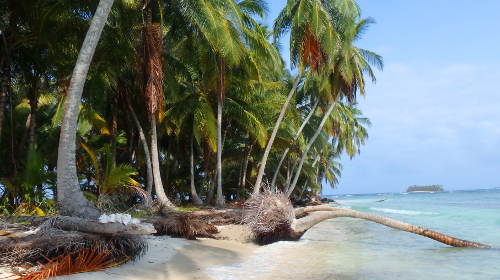
The question is whether the kunas can resist the temptation of 'progress'. We sailors are of course partly to blame for introducing all kinds of modern things and, for example, handing out cold cans of soda to Kuna's who come to have a chat.
There is another threat to the Kunas: the rising sea levels. All these islands can only exist thanks to the reefs that protect the islands from the violence of the Caribbean Sea. These reefs are so high that they often only stand four inches of water above them, so that every wave breaks and only flat water remains after the reef. But when the sea rises ten centimeters, the water level above the reef has doubled and the waves can wash over the reef and reach the islands. The sea level is rising faster than the coral is growing and indeed, some islands have already disappeared and we see with our own eyes how the islands slowly dissolve and the palm trees, losing their foundation, fall into the water ...
Kuna Yala is a pearl with about 365 islands. We thoroughly enjoyed the beautiful islands and the sea and the change between inhabited and uninhabited. Sailing on smooth water. Looking out our eyes and partly experiencing the so incredibly different culture and the little people. We wish we could have had more time. Let's hope this doesn't all go away!
